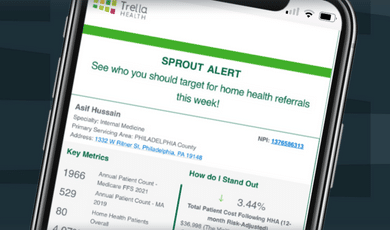In recent years – there has been some noise in the post-acute care industry regarding Medicare changes, specifically around agencies adjusting to the combination of Medicare Fee-for-Service and Medicare Advantage.
It seems this combination has become a major headwind for home health and potentially hospice agencies – when it comes to reimbursement rates.
Below are three key takeaways we will discuss in further detail throughout this blog:
- The Hospice Benefit Component of VBID could make a significant headwind for hospice agencies
- The transition from Fee-for-Service (FFS) to a combination with Medicare Advantage significantly reduced revenue for home health agencies
- How will the Hospice Benefit Component of VBID impact hospice agencies?
We understand these models and plans are still changing and updating – please note this information will be updated once we have the latest information.
Let’s dive in!
The hospice carve-in could make a significant headwind for hospice agencies
What is the Value-Based Insurance Design Model or VBID?
According to the Centers for Medicare and Medicaid (CMS), the Value-Based Insurance Design Model or VBID refers to “health insurers’ efforts to structure cost-sharing and other health plan design elements to encourage enrollees to use the services that can benefit them the most.”
So, what does this mean exactly?
It means the model was designed to test different Medicare Advantage (MA) services/payment plans to aid the modernization of MA by lowering costs and improving patient care for Medicare beneficiaries.
Note: the VBID model started on January 1, 2017, and was recently extended through 2030.
What is the Hospice Benefit Component of VBID?
According to CMS – The Hospice Benefit Component of VBID also known as the hospice carve-in model is “when an enrollee in an MA plan elects hospice, Fee-for-Service (FFS) Medicare becomes financially responsible for most services, while the MAO retains responsibility for certain services (e.g., supplemental benefits). Under the Hospice Benefit Component of the VBID Model, participating MAOs retain responsibility for all Original Medicare services, including hospice care.”

Note: The Hospice Benefit Component of VBID model started on January 1, 2021, and is in effect until December 31, 2024.
Additional reading: Read about the preliminary impact of the VBID Hospice Cave-in in the latest Industry Trend Report.
The transition from Fee-for-Service to a combination with Medicare Advantage significantly reduced revenue for home health agencies
It’s widely known throughout the post-acute care industry that Medicare Advantage reimbursement rates are lower than Fee-for-Service.
Consequently, home health agencies have seemed to have drawn the short straw when it comes to the combination of Medicare Advantage and Fee-for-Service plans. For instance, home health agencies typically receive less reimbursement per patient/claim for Medicare Advantage plans.
So, what can home health agencies do?
Unfortunately, the data related to Medicare Advantage reimbursement for home health agencies is protected and publicly unknown due to its competitive market. If Medicare Advantage plans knew what the other was charging, they could easily come in and steal home health agencies under the rug from each other.
Therefore, home health agencies receive a lower reimbursement from Medicare Advantage – compared to Medicare Fee-for-Service plans – and take their Medicare Advantage patients at a loss just to maintain the relationship.
Hopefully, in the coming years Medicare Advantage plans and home health agencies will be able to meet in the middle and find a win-win situation for both.
How will the Hospice Benefit Component of VBID impact hospice agencies?
So, will hospice agencies experience the same fate as home health agencies when it comes to the Hospice Benefit Component of VBID?
It’s hard to tell at this point in time – but seeing how the model poorly impacted the home health industry, it’s unlikely that it will be different for hospice agencies.
However, hospice agencies do have an advantage with the amount of money for end-of-life care that is being saved.
MA plans could have a larger incentive to pick higher quality hospice agencies due to this advantage. Unfortunately – with how MA plans utilized a bidding war strategy to pick home health agencies – it’s unlikely they will change their strategy when picking hospice agencies.
In addition – it’s harder for home health agencies to illustrate their value proposition but, at this point, it’s unknown if MA plans will take value propositions into account.
What we do know is best case scenario – hospice agencies will have to endure the combination of Fee-for-Service and MA plans.
At worst, they will have to take a cut of reimbursement rates to continue to do business with plans that have Medicare Advantage enrollment.
It will be important to keep an eye on this in the coming years and see how hospice agencies are affected by Medicare Advantage reimbursement rates compared to home health agencies.
Note: We will continue to keep you updated as more information is available.
What’s next for VBID?
It will be interesting to see how hospice agencies will do with Medicare Advantage reimbursement rates and if they will face the same fate as home health agencies.
We understand the models and plans discussed throughout this blog are still being tested and are relatively new to the industry.
This blog will be updated when new information becomes available to keep you informed and up to date.
Interested in VBID, the Hospice Benefit Component of VBID, or how Medicare Advantage plans combine with Medicare Fee-for-Service? Take the next step by exploring Trella Health’s innovative products. Discover how our solutions empower healthcare organizations with valuable insights and data, allowing them to make informed decisions and enhance patient care. To learn more, don’t hesitate to reach out to us for a personalized demo at https://www.trellahealth.com/demo














